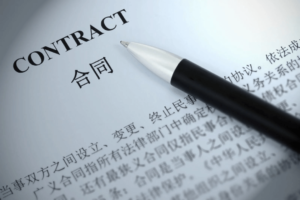Even though Chinese consumers are becoming more familiar with foreign language marks, they will likely still use Chinese language marks to talk about foreign brands. So, it should always be a top priority for foreign companies doing business in China to get legal protection, stop trademark infringement, make sure a brand has the exclusive right to use in China, create Chinese language marks, and make sure they are registered.
This article aims to explain the importance of trademark protection in China, the Chinese translation of a trademark in roman characters, the unique trademark system in China that is following the Nice classification but also has its own subclasses, This is especially important since the registration of a mark according to the China Trademark Law and the Chinese government leans more toward a trademark registration process where succeeding with the registration of trademarks is more based on a file principle of first-to-file approach than the evidence of use.
As the Chinese economy keeps growing, foreign applicants who sell in the Chinese market or manufacture products in China that will be exported should be aware of how China operates when it comes to the protection of intellectual property rights, what one should pay attention to when applying for trademarks, how to make a Chinese version of a Western brand, what products or services should be protected when entering the Chinese market and so on.
Table of Contents
ToggleTrademark application in China: What are the benefits of registering Chinese trademarks?
It is crucial for many companies and business owners to localize foreign brand names. This is also important for the trademark registration application. Since China’s official language is Chinese, the Chinese consumer will inevitably use Chinese to refer to foreign brands, as Chinese brand names are easier to remember and pronounce.
Chinese language trademarks can save brand owners time and money in getting their brands recognized in China.
And despite only foreign language marks attached to the products, trademarks in Chinese are still needed for marketing purposes, as most sales and marketing activities in China are done in Chinese. And if there is no official Chinese name for your brand, third parties like for example local distributors, retailers, media, and consumers will tend to devise their own versions in China, which may weaken your marketing campaign.
Further, there is no guarantee that the Chinese names chosen by the trademark owner of the foreign brand will be approved according to the different subclasses it is applied for in a trademark review, aligned with its image, or carry positive connotations. Worse still, once Chinese names become associated with a brand, they may be difficult to change.
By registering appropriate official Chinese language marks at the earliest possible stage, brand owners are able to retain control over their Chinese brand names and prevent unwanted names from being used to refer to their brands.

A trademark filing? Good faith? Getting rid of squatters
As China and the China Trademark Office adopt a first-to-file system, if brand owners do not register their desired Chinese brand names quickly enough, they may find it difficult to secure trademark registration at a later stage in the different classes of products and services that are needed.
It is not uncommon for trademark squatters in China to file registration of the trademarks for a Chinese counterpart of a foreign brand, including names commonly used to refer to them. Such bad faith registrations will disrupt the business of brand owners and block their applications for the Chinese marks they desire. The longer the delay in registering the desired Chinese marks, the fewer choices and the more obstacles the brand owners will encounter.
Local trade and social media platforms are typically reluctant to remove ads and product listings unless the brand owner can provide registration certificates for such Chinese language trademarks to expose counterfeit.
Trademark registration in China and how Chinese language marks should be registered to succeed in the Chinese market
China Trademark Registration: The Name of the Trademark
A trademark in Chinese should be easy to remember and pronounce and have good connotations.
Do remember that each Chinese character has a specific meaning and isn’t simply a sound. Thus, even when transliterated, each character will still retain its meaning.
Furthermore, there are many homophones in Chinese. For example, the Chinese character ‘一’ that means ‘one’, ‘衣’ means ‘clothing’ or ‘garment’, and ‘医’ meaning ‘doctor’, ‘medicine’ or ‘medical science’ are all pronounced as ‘yi’. Thus, in a translation into Chinese, it is important to pick the Chinese characters that complement your brand identity and positively affect Chinese characters.
Therefore, it is worth the time and effort to develop the appropriate Chinese character marks for your brand image and positioning when you file a trademark in China.

Trade Mark Registration: Methods for choosing a Chinese trademark
1. Trademark in Chinese characters: Using meaning-based translation
When a mark has an equivalent meaning in Chinese, brand owners are permitted to adopt the direct meaning in Chinese of the foreign-language mark. For example, Píng guǒ 苹果 which literally means ‘apple’ for Apple, or if the Chinese-equivalent dictionary meaning for each character of the mark is defined, such as Wēi ruǎn 微软’ for Microsoft. Here the first Chinese character wēi 微 means ‘micro’ and the last character ruǎn 软 means ‘soft’.
2. Transliteration by pronunciation
With four Chinese tones, one trademark can be translated into many Chinese characters.
Four tones distinguish words and characters in Mandarin Chinese. First, we have the first tone or a high-level mā, the second tone, which is a rising má, the third tone, which is a falling-rising mǎ, and then finally the fourth tone, which is falling.
An example here is the “ma” pronunciation in Chinese. Here we can see how much the pronunciation of a translated Chinese brand name means. The first tone mā, might mean “mother” 妈, the second tone is pronounced má and might mean “hemp”麻, the mǎ pronunciation is the third tone and might mean “horse” 马, and the mà is a fourth tone might mean to “scold” 骂 someone.
Therefore, it is not easy to get good transliterations that have a good pronunciation and use Chinese characters that are able to represent the brand in a good way.
Let us do a quick trademark search. What Chinese trade name does your favorite brand have in China? For example, do we see that the supermarket Carrefour uses Jiā lè fú 家乐福, Armani uses Ā mǎ ní 阿玛尼, Nike uses Nài kè 耐克 and Adidas has the Chinese name Ā dí dá sī 阿迪达斯.
The Chinese pronunciations of the above trademarks are the same or very similar to their original brand names. If the pronunciations are not the same, then there is little or no connection between the Chinese and the original name. The closer the pronunciations are, the closer the connection between the trademarks.
For many companies, it makes sense to have four-folded trademark protection in China: 1. The name of your original brand name, 2. Mandarin Chinese translation of your trademark, 3. Logo, 4. Chinese words or words that may be very similar to what you use or that you’d like to prevent others from using
If you wish to register a trademark in Mandarin Chinese, it should be the name of your company or brand, since it is the one most likely to be recognized, spoken about, and used in China itself.
As a general rule, it is wise to register Chinese marks with identical or similar pronunciations in order to prevent competitors from registering similar Chinese marks. As a result, an unmeaningful mark composed of many characters is not a useful transliteration.
In fact, Chinese consumers are more likely to recall marks with meaning and fewer characters because they are short and easy to remember. Thus, two or three-character Chinese names are the most popular. For consumers to remember brands efficiently, it is advisable to choose widely used characters.
For foreign aplicants, it is also important to to remember that foreign brands can be transliterated into many Chinese characters because of the four tones in the Chinese language. And finally, every Chinese character carries a certain meaning, so you do not want to choose characters that have a bad meaning. Thus, you may need help with the translation and search to see if the option you choose has already been registered.
3. A combination: Translating from the sounds and meaning
Because brand names can be transliterated into so many different Chinese characters, it is best to choose characters that are meaningful and impress consumers.
Have you heard the Chinese word “ke kou ke le”? This is Coca-Cola, right? That is correct.
Coca-Cola uses the phonetic translation Kě kǒu kě lè 可口可乐. Kě kǒu 可口 means ‘thirsty’ and the last character lè 乐 ‘happy’. Transliterations can be embellished by making the Chinese brand name sound phonetically similar to its foreign counterpart, matching the brand’s image, and sound appealing to Chinese consumers.
Yí jiā 宜家 is the brand name that IKEA is using in China, a name which means ‘suitable for home’.
What else do you need to remember when registering a trademark in China?
It is not allowed to register descriptive marks under Chinese trademark law. Trademarks should not directly refer to the quality or functionality of the goods.
It is not easy for a trademark applicant to develop a transliteration that incorporates all the above principles. A phonetically similar mark may not mean the same thing, or it may be too long and difficult to remember.
A Chinese mark transliterated or translated from another language to Chinese should not result in similar or identical names as Chinese trademarks. In this situation, the brand name must be retranslated into Chinese.
In addition to the protection of a Chinese brand in Mainland China, do also remember that you cannot apply for similar goods and services inside of the same trademark category as another brand. However, this does not necessarily mean that you can not be protected in the same main trademark category as a similar name if you are protected in different subclasses in the Chinese trademark system.
There is also a time limit of three years from the registration date until you have to be actively doing business in China. The application documents have to be signed by the legal person in order for them to be valid in a Chinese court.
You also should remember that China is its own legal area. So the trademark protection in China should be filed to the Trademark Office of China with all the required documents. While you may be protected in Hong Kong, the only way to protect yourself in China (file country) is to do a registration of the trademark there to ensure you have the trademark rights in China.
Finally, it is essential to remember that China uses a first-to-file system. Those who file a trademark first in China own it if the application is accepted. Therefore, it is vital to protect a brand as early as possible. This is important not just for companies selling in the Chinese market, but also for companies producing their products in China.
So when you are having branded goods and file a trademark to the China National Intellectual Property Administration, for many companies it would be crucial to also protect the Chinese version of a Western trademark. Because you want to have steady business growth, thus protecting your brand should be a part of your business strategy in China. When you seek to file international trademarks including China, you should be aware that protecting a trademark in roman characters does not automatically mean that your brand is protected in China.
Do you need help with protecting your intellectual property in China: trademarks, copyright, and patents?
If you need help with obtaining trademark protection, copyright, and protecting your patents in China, please contact us here. We also offer help with background checks of Chinese companies, verifications of NDAs and contracts in China, etc.









